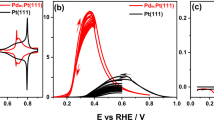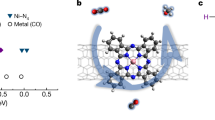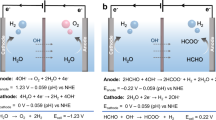Abstract
The wide deployment of electrocatalytic hydrogenation may be hindered by intrinsic limitations, including substrate solubility and difficult separation of the products from the electrolyte. The use of palladium membrane electrodes can overcome the aforementioned limitations by physically separating the formation of reactive hydrogen atoms from the hydrogenation of unsaturated organic substrates. Here, by taking advantage of the low-potential oxidation of formaldehyde on a palladium membrane anode to produce hydrogen that can permeate through the membrane electrode, we demonstrate that electrocatalytic dual hydrogenation of unsaturated dicarboxylic acids is possible when another palladium membrane electrode is also adopted as the cathode. Such a design enables the electrocatalytic hydrogenation of the same substrate at both the anode and cathode in two separated chambers spatially isolated from the electrochemical cell with a theoretical maximum Faradaic efficiency of 200%.

This is a preview of subscription content, access via your institution
Access options
Access Nature and 54 other Nature Portfolio journals
Get Nature+, our best-value online-access subscription
$29.99 / 30 days
cancel any time
Subscribe to this journal
Receive 12 digital issues and online access to articles
$119.00 per year
only $9.92 per issue
Buy this article
- Purchase on Springer Link
- Instant access to full article PDF
Prices may be subject to local taxes which are calculated during checkout






Similar content being viewed by others
Data availability
The data that support the findings of this study are included in the published article and the Supplementary Information. Further queries about the data can be directed to the corresponding author. Source data are provided with this paper.
References
Augustine, R. L. Catalytic Hydrogenation: Techniques and Applications in Organic Synthesis (Marcel Dekker, 1965).
Zhang, L., Zhou, M., Wang, A. & Zhang, T. Selective hydrogenation over supported metal catalysts: from nanoparticles to single atoms. Chem. Rev. 120, 683–733 (2020).
Jagadeesh, R. V. et al. Nanoscale Fe2O3-based catalysts for selective hydrogenation of nitroarenes to anilines. Science 342, 1073–1076 (2013).
Cui, X. et al. Highly selective hydrogenation of arenes using nanostructured ruthenium catalysts modified with a carbon–nitrogen matrix. Nat. Commun. 7, 11326 (2016).
Friedfeld, M. R., Zhong, H., Ruck, R. T., Shevlin, M. & Chirik, P. J. Cobalt-catalyzed asymmetric hydrogenation of enamides enabled by single-electron reduction. Science 360, 888–893 (2018).
Mas-Rosello, J., Smejkal, T. & Cramer, N. Iridium-catalyzed acid-assisted asymmetric hydrogenation of oximes to hydroxylamines. Science 368, 1098–1102 (2020).
Lee, S. et al. Dynamic metal–polymer interaction for the design of chemoselective and long-lived hydrogenation catalysts. Sci. Adv. 6, eabb7369 (2020).
Bondue, C. J., Calle-Vallejo, F., Figueiredo, M. C. & Koper, M. T. M. Structural principles to steer the selectivity of the electrocatalytic reduction of aliphatic ketones on platinum. Nat. Catal. 2, 243–250 (2019).
Akhade, S. A. et al. Electrocatalytic hydrogenation of biomass-derived organics: a review. Chem. Rev. 120, 11370–11419 (2020).
Gnaim, S. et al. Cobalt-electrocatalytic HAT for functionalization of unsaturated C–C bonds. Nature 605, 687–695 (2022).
Fokin, S. Z. Die Rolle der Metallhydride bei Reduktionsreaktionen und neue Daten zur Erklärung der Frage über die Zusammen-Setzung einiger Fette und Trane. Z. Elektrochem. Angew. Phys. Chem. 12, 749–768 (1906).
Lessard, J. Organic Electrochemistry (eds Hammerich, O. & Speiser, B.) 1658–1664 (CRC, 2015).
Li, T., Cao, Y., He, J. & Berlinguette, C. P. Electrolytic CO2 reduction in tandem with oxidative organic chemistry. ACS Cent. Sci. 3, 778–783 (2017).
You, B. & Sun, Y. Innovative strategies for electrocatalytic water splitting. Acc. Chem. Res. 51, 1571–1580 (2018).
Sbei, N., Hardwick, T. & Ahmed, N. Green chemistry: electrochemical organic transformations via paired electrolysis. ACS Sustain. Chem. Eng. 9, 6148–6169 (2021).
Cardoso, D. S. P., Šljukić, B., Santos, D. M. F. & Sequeira, C. A. C. Organic electrosynthesis: from laboratorial practice to industrial applications. Org. Process Res. Dev. 21, 1213–1226 (2017).
Inoue, H., Abe, T. & Iwakura, C. Successive hydrogenation of styrene at a palladium sheet electrode combined with electrochemical supply of hydrogen. Chem. Commun. 55–56 (1996).
Iwakura, C., Yoshida, Y. & Inoue, H. A new hydrogenation system of 4-methylstyrene using a palladinized palladium sheet electrode. J. Electroanal. Chem. 431, 43–45 (1997).
Iwakura, C., Abe, T. & Inoue, H. A new successive system for hydrogenation of styrene using a two-compartment cell separated by a Pd sheet electrode. J. Electrochem. Soc. 143, L71–L73 (1996).
Sherbo, R. S., Delima, R. S., Chiykowski, V. A., MacLeod, B. P. & Berlinguette, C. P. Complete electron economy by pairing electrolysis with hydrogenation. Nat. Catal. 1, 501–507 (2018).
Delima, R. S., Sherbo, R. S., Dvorak, D. J., Kurimoto, A. & Berlinguette, C. P. Supported palladium membrane reactor architecture for electrocatalytic hydrogenation. J. Mater. Chem. A 7, 26586–26595 (2019).
Devanathan, M. A. & Stachurski, Z. The absorption and diffusion of electrolytic hydrogen in palladium. Proc. R. Soc. A 270, 90–102 (1962).
Zheng, J., Sheng, W., Zhuang, Z., Xu, B. & Yan, Y. Universal dependence of hydrogen oxidation and evolution reaction activity of platinum-group metals on pH and hydrogen binding energy. Sci. Adv. 2, e1501602 (2016).
Van Den Meerakker, J. E. A. M. On the mechanism of electroless plating. I. Oxidation of formaldehyde at different electrode surfaces. J. Appl. Electrochem. 11, 387–393 (1981).
Machida, K. & Enyo, M. Formaldehyde electro-oxidation on copper metal and copper-based amorphous alloys in alkaline media. Bull. Chem. Soc. Jpn 58, 2043–2050 (1985).
Wang, T. et al. Combined anodic and cathodic hydrogen production from aldehyde oxidation and hydrogen evolution reaction. Nat. Catal. 5, 66–73 (2022).
Trincado, M., Grützmacher, H. & Prechtl, M. H. G. CO2-based hydrogen storage—hydrogen generation from formaldehyde/water. Phys. Sci. Rev. 3, 20170013 (2018).
Wang, C. & Astruc, D. Recent developments of nanocatalyzed liquid-phase hydrogen generation. Chem. Soc. Rev. 50, 3437–3484 (2021).
Beltowskabrzezinska, M. Electrochemical oxidation of formaldehyde on gold and silver. Electrochim. Acta 30, 1193–1198 (1985).
Beltowskabrzezinska, M. & Heitbaum, J. On the anodic oxidation of formaldehyde on Pt, Au and Pt/Au-alloy electrodes in alkaline solution. J. Electroanal. Chem. 183, 167–181 (1985).
Martin, R. J. The mechanism of the Cannizzaro reaction of formaldehyde. Aust. J. Chem. 7, 335–347 (1954).
Fukai, Y. The Metal–Hydrogen System: Basic Bulk Properties (Springer, 2006).
Holland, T. J. B. & Redfern, S. A. T. Unit cell refinement from powder diffraction data: the use of regression diagnostics. Mineral. Mag. 61, 65–77 (1997).
Maeland, A. & Flanagan, T. B. Lattice constants and thermodynamic parameters of the hydrogen–platinum–palladium and deuterium–platinum–palladium systems. J. Phys. Chem. 68, 1419–1426 (1964).
Benck, J. D., Jackson, A., Young, D., Rettenwander, D. & Chiang, Y.-M. Producing high concentrations of hydrogen in palladium via electrochemical insertion from aqueous and solid electrolytes. Chem. Mater. 31, 4234–4245 (2019).
Bozell, J. J. & Petersen, G. R. Technology development for the production of biobased products from biorefinery carbohydrates—the US Department of Energy’s ‘Top 10’ revisited. Green. Chem. 12, 539–554 (2010).
Wojcieszak, R. et al. Recent developments in maleic acid synthesis from bio-based chemicals. Sustain. Chem. Process. 3, 9 (2015).
Pinazo, J. M., Domine, M. E., Parvulescu, V. & Petru, F. Sustainability metrics for succinic acid production: a comparison between biomass-based and petrochemical routes. Catal. Today 239, 17–24 (2015).
Suenobu, T., Isaka, Y., Shibata, S. & Fukuzumi, S. Catalytic hydrogen production from paraformaldehyde and water using an organoiridium complex. Chem. Commun. 51, 1670–1672 (2015).
Fetzer, M. N. A., Tavakoli, G., Klein, A. & Prechtl, M. H. G. Ruthenium‐catalyzed E‐selective partial hydrogenation of alkynes under transfer‐hydrogenation conditions using paraformaldehyde as hydrogen source. ChemCatChem 13, 1317–1325 (2021).
Kurimoto, A. et al. Physical separation of H2 activation from hydrogenation chemistry reveals the specific role of secondary metal catalysts. Angew. Chem. Int. Ed. 60, 11937–11942 (2021).
Acknowledgements
Y.S. acknowledges the financial support of the National Science Foundation (CHE-1914546 and CHE-2102220), the Herman Frasch Foundation (820-HF17), the Michelman Green, Clean and Sustainable Technology Research Innovation Program, and the University of Cincinnati.
Author information
Authors and Affiliations
Contributions
Y.S. conceived the idea and supervised the project. G.H. and G.L. performed the experimental work and data analysis. G.H. and Y.S. wrote the manuscript.
Corresponding author
Ethics declarations
Competing interests
Y.S. has filed a provisional patent application related to this manuscript (US patent provisional 63/440,044). All other authors declare no competing interests.
Peer review
Peer review information
Nature Catalysis thanks Shuangyin Wang, Hongyuan Sheng and the other, anonymous, reviewer(s) for their contribution to the peer review of this work.
Additional information
Publisher’s note Springer Nature remains neutral with regard to jurisdictional claims in published maps and institutional affiliations.
Supplementary information
Supplementary Information
Supplementary Methods, Figs. 1–45 and ref. 1.
Supplementary Data 1
Source data for the figures in the Supporting Information.
Source data
Source Data Fig. 2
Data used to plot the figures.
Source Data Fig. 3
Data used to plot the figures.
Source Data Fig. 4
Data used to plot the figures.
Source Data Fig. 5
Data used to plot the figures.
Source Data Fig. 6
Data used to plot the figures.
Rights and permissions
Springer Nature or its licensor (e.g. a society or other partner) holds exclusive rights to this article under a publishing agreement with the author(s) or other rightsholder(s); author self-archiving of the accepted manuscript version of this article is solely governed by the terms of such publishing agreement and applicable law.
About this article
Cite this article
Han, G., Li, G. & Sun, Y. Electrocatalytic dual hydrogenation of organic substrates with a Faradaic efficiency approaching 200%. Nat Catal 6, 224–233 (2023). https://doi.org/10.1038/s41929-023-00923-6
Received:
Accepted:
Published:
Issue Date:
DOI: https://doi.org/10.1038/s41929-023-00923-6
This article is cited by
-
Electrochemical hydrogenation and oxidation of organic species involving water
Nature Reviews Chemistry (2024)
-
Interfacial Electronic Modulation of Dual-Monodispersed Pt–Ni3S2 as Efficacious Bi-Functional Electrocatalysts for Concurrent H2 Evolution and Methanol Selective Oxidation
Nano-Micro Letters (2024)
-
Green electrosynthesis of 3,3’-diamino-4,4’-azofurazan energetic materials coupled with energy-efficient hydrogen production over Pt-based catalysts
Nature Communications (2023)
-
Doubling the efficiency of electrosynthesis
Nature Catalysis (2023)
-
Separate electro from the chemistry
Nature Catalysis (2023)



